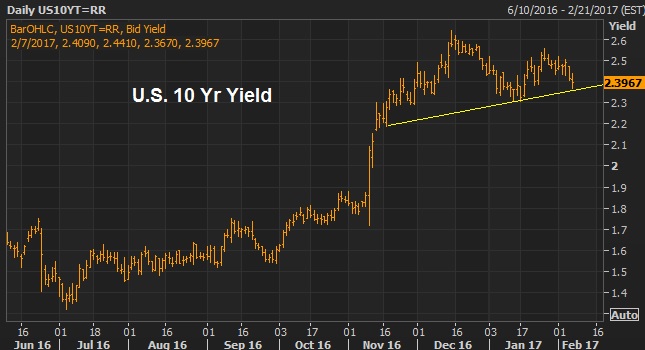March 17, 2017, 4:00pm EST Invest Alongside Billionaires For $297/Qtr
With the Fed’s third rate hike this week in the post-financial crisis era, let’s take a look at how market rates have reponded.
Here’s a chart of the U.S. 10 year government bond yield.

On December 16, 2015, the Fed moved for the first time. The 10-year traded up to 2.33% that day and didn’t see that level again for 11-months. Despite the fact that the Fed forecasted four hikes over the next twelve months, the bond market wasn’t buying it. A month later, the fall in oil prices turned into a crash. And the 10 year yield printed a new record low at 1.32%, just under the crisis lows.
On December 14, 2016, the Fed made the second move. This was after they had spent the better part of the last nine months walking back on what they thought would be their 2016 hiking campaign. The difference? Trump was elected the new President and he was already fueling confidence from talk of big, bold fiscal stimulus. The Fed’s big hiking campaign was placed back on the table. The high in yields the day the Fed made hike #2 was 2.58%. The next day it put in a top at 2.64% that we have not seen since.
And, of course, this past week, we’ve had hike #3. The 10 year yield traded up to 2.60% that day (Wednesday) and we haven’t seen it since, despite the fact that the Fed has continued to tell us another couple of hikes this year, and that the economy is doing well, expect about three hikes a year through 2018. Yields go out at 2.50% today.
So why aren’t market rates screaming? The 10 year yield should be 3.5%+ by now. And consumer rates should be surging. Is it the Bank of Japan, the European Central Bank and China buying our Treasuries, keeping a cap on yields? Is it that the market doesn’t believe it and thus the yield curve is flattening (which would project recession)? Probably a bit of both. The important point is that the Fed absolutely cannot do what they are doing if they think they will push the 10 year yield up to 3.5%+, and fast.
In our Billionaire’s Portfolio, we’re positioned in a portfolio of deep value stocks that all have the potential to do multiples of what broader stocks do — all stocks owned and influenced by the world’s smartest and most powerful billionaire investors. Join us today and we’ll send you our recently recorded portfolio review that steps through every stock in our portfolio, and the opportunities in each.


